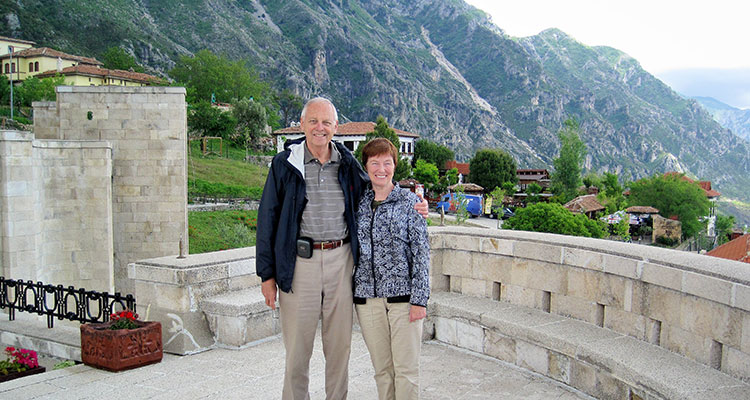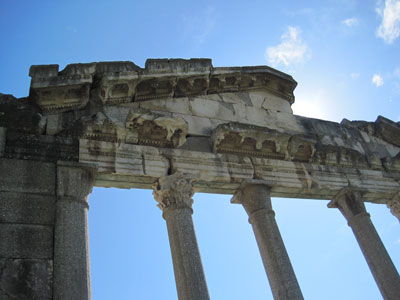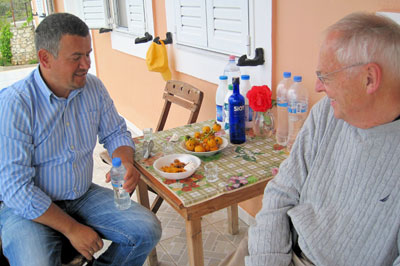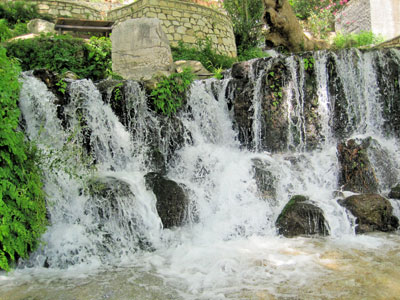Albania – enjoying Europe without the costs and crowds
This article appears on page 36 of the December 2012 issue.
by Carol Probst; Bethel Park, PA
While waiting in Rome to board our plane to Albania in May of 2012, I got into a brief discussion with an Albanian woman who was living in the US. She was returning to Albania to visit family and asked if we had relatives or business dealings there. When I replied, “Neither,” she responded, “Then why would you go?”
My heart sank. Not her, too! This was what my husband and I had been hearing for months from family and friends, and I wondered if my decision to visit for a week was a big mistake.
The decision certainly was an impulsive one, conceived after reading a short but enthusiastic write-up in ITN (Jan. ’12, pg. 4). The subscriber extolled the beauty and historical attractions of Albania while recommending the services of Albania TravelNet (Tirana, Albania; phone +355 694073477).
In my opinion, much of Europe has become too crowded. Albania was a country not even on my radar; in fact, I was uncertain of its exact location, so, I reasoned, it surely must have fewer visitors. I was seized with the urge to visit it.
When my husband, Lynn, agreed, I contacted Enea Kumi of Albania TravelNet to arrange a private tour. Knowing very little about the country, I gave him virtual carte blanche with the itinerary, though I emphasized that we loved ethnic food and were interested in natural beauty and historical attractions, not “shopping opportunities.”
Arriving in Albania
Tirana International Airport was a pleasant surprise — modern and clean — and Enea was waiting for us at the gate. He spoke English fluently and his car, a Mercedes, was almost identical to the one we had at home. This had to be a good sign!
In Albania, bus transportation is limited, and trains are sad-looking specimens — only three or four cars in length, covered with graffiti and with missing or broken windows. Our only remaining option was to travel by car, and, Lynn and I agree, it is imperative to utilize a guide/driver. Even some of the major roads in Albania could easily win our annual “Pittsburgh pothole” contest. Moreover, portions of their State Road are almost disintegrated. (We were told that a new highway was under construction.)
Traffic is such that patience and daring are necessary to cross the boulevards in Tirana, and in the villages there were narrow streets where folks parked with impunity. Most cars had nicked side-view mirrors or worse.
Equally challenging, directional signs were scarce and it was not always easy to find English-speaking Albanians, especially in rural areas.
On the last afternoon of our trip, while returning to Tirana we encountered a 2-hour torrential downpour. As the car slowed to a crawl, Enea appeared unfazed and I, sitting in the backseat, was enjoying the rain-swept panorama. However, my husband, up front, had no illusions about the road conditions and later told me they were terrifying. Thank goodness we had a skilled driver who was familiar with the roads.
Hospitality
Contrary to our family’s fears, we found the country safe for visitors. Albanians adhere to the Kanun, ancient laws of conduct, one of which addresses the treatment of guests.
To paraphrase, when someone knocks at your door, he must be graciously admitted. Not only that but the host is totally responsible for assuring his guest’s safety and happiness. Failing to do so results in loss of bessa, or honor. This translates to a very protective attitude toward visitors.
Enea recalled one incident where a Czech visitor had his camera stolen. The entire police force was mobilized and such a fuss ensued that the Czech ambassador finally had to step in to insist they call off their manhunt. Thieves, well aware of these policies, tend to leave tourists alone.
And here’s the best part: Albanians seem to really like America. (Enea attributed this to Woodrow Wilson’s championship of their independence and, more recently, America’s role in helping to end the Serbian ethnic cleansing of Albanians in Kosovo.) We were stunned to see a statue of George W. Bush in the tiny village of Fushe Krujë commemorating his 2007 visit there.
I can’t tell you how many folks asked about our nationality and then, when Enea responded, “Americanos,” burst into big smiles of welcome.
When we visited the beautifully painted Et’Hem Mosque in Tirana, the local Imam overheard us talking. A pleased expression spread over his face and he began an animated conversation with Enea, apparently insisting that we take photos not only of the mosque, itself, but of the most treasured artifacts it contained.
The food
We found the food in Albania to be absolutely delicious. Influenced by Greek and Turkish cuisine, it features local seafood, meats and produce.
Yogurt sauce with cucumbers, rice-stuffed grape leaves and spinach pie in phyllo dough are foods I had enjoyed in the US, but in Albania they were transformed into something amazing! The seafood was incredibly fresh, and the roasted meats and vegetables were really yummy!
I could detect hints of oregano, cumin, fennel and cloves in the huge portions we were served. (Enea explained that Albanians take pride in serving so much food that something will always remain on the table.)
Our most expensive meal was at the Aragosta Restaurant in Durrës. After selecting fish for grilling out of a big ice cooler, we sipped wine and watched a glorious sunset over the ocean. The total cost? Forty-eight dollars for two.
Conversely, our cheapest dinner was in a tiny café run by Hotel Gjirokastra, where the three of us enjoyed a 5-course feast. The bill came to just $16.
During our tour we had but one request for dining: to enjoy traditional foods in restaurants where Albanians would eat. Under this stipulation, Enea took charge of the menus, and I can honestly say that we savoured every bite and usually were too stuffed for the delicious desserts — a sad conundrum.
Alluring landscapes
And what about the “natural beauty” we were seeking? Well, Albania has that in spades.
Located just north of Greece, the country boasts the same dramatic coastline of cascading villages perched on mountains that plunge into the sea. The difference? There was no traffic or jostling with other tourists for the best viewpoint or patch of sand. (Although, to be fair, perhaps May was not the best month to assess the beach crowds.)
Even away from the coast, I found the landscape fascinating. Arid mountains, streaked with erosion, were ablaze with yellow bushes of broom and pink and purple wildflowers nestled in rocky crannies.
Blue Eye, the most famous of Albania’s more than 200 springs, located approximately a half hour from Saranda, was also lovely, its clear waters deepening to an electric-blue circle that resembled an eye at the center of the spring.
The two of us really enjoyed Llogara National Park, where, at 1,100 meters above sea level, we stopped at a café atop an overlook. An approaching storm had cut off all electricity. As the only customers, we were served mugs of delicious herbal mountain tea (heated over a small gas burner) while our table by the window provided front-row seats to nature’s show.
Clouds, at eye level, rushed through the pass on their way to the valley below, then, just as suddenly as it had started, the storm ceased, the sun broke through and the coastline appeared beyond the valley. Magical!
The unexpected
On our first night, Enea brought us a great bottle of wine from the Çobo Winery near Berat. Lynn asked if we could swing by to purchase more bottles when in the area.
Çobo Winery is situated amidst cultivated vineyards at the base of Mt. Tomorri. There, we met the owner and his family, took a quick peek at the wine-making process and admired the flower-bedecked tasting rooms (and, of course, bought some wine).
Later on our tour, a chance encounter with some of Enea’s relatives led to a wonderful interlude. Ensconced on their veranda overlooking the sea, we sipped homemade raki, a potent national drink, while nibbling on freshly picked loquats.
Another surprise was Albania’s architecture. I must admit to having low expectations, since Communist rule in other countries seems to have produced a plethora of unattractive concrete buildings and apartments. Despite some evidence of this in Albania, there were certainly buildings worth noting.
The main square in Tirana was designed by the Italians, who occupied the country during World War II. Broad boulevards suitable for parades are lined by grand Italianate buildings decked out in hues of gold and orange.
The small hillside villages seemed to have been spared from Communist reconstruction along with the UNSECO World Heritage Sites of Berat and Gjirokastra. The latter, as the birthplace of Enver Hoxha, was declared a “museum town” during his rule, effectively preserving its original architecture.
The Ottoman influence was strong there, and a number of kullë (tower houses) still exist. A replica of Hoxha’s home, furnished and decorated in the traditional manner, features the rich interior details and fabrics typical of the kullë.
Towering over the town is an ancient fortress that was seized and enlarged in the 19th century by the infamous Ali Pasha. In the early 1930s it became a prison, remaining one for over 40 years. It now serves as a military museum.
Overcast skies and drizzle befitted this unsettling place. Inside, the occasional bare electric bulb cast an eerie glow, and looming out of the shadows were tanks and artillery guns.
A museum on an upper floor held additional weaponry as well as a compelling statue of an Albanian resistance fighter’s last moments.
Historical sites
Before I talk about Albania’s historical attractions, I must give a disclaimer: for sheer “Wow!” factor, Albania’s most famous ruins, Butrint and Apollonia, pale in comparison to those we’ve seen in Ephesus, Turkey, and Jerash, Jordan. However, under Enea’s tutelage, we began to appreciate the complexity and beauty of these Albanian treasures.
The extensive complex at Butrint reflects its occupation by numerous civilizations, each culture building over and/or incorporating the buildings of the previous one. We saw a number of ruins, including Greek walls and an amphitheater (sixth to fourth century BC), Roman baths (second century BC), a Byzantine bapistry and a necropolis from the sixth century.
Moreover, unlike in Ephesus, there was a minimal number of tourists (one busload and a few independents) and there were pleasantly shaded grounds.
Apollonia, centered around the Temple of Apollo, was once the second-largest Greek colony in Albania. It continued to flourish under Roman rule as an important port city until an earthquake in the third century rerouted the nearby river.
Although excavation began during WWI, progress has been slow and, supposedly, only 10% of the site has been uncovered, including an ancient theater, a library and a stoa (marketplace) with a cistern. A 13th-century monastery on site houses the small museum.
Wildflowers were sprouting amongst the stones, and we practically had the whole place to ourselves. I counted eight other people.
However, the prize for the least number of visitors goes to the second-century Roman amphitheater in Durrës. There, the three of us were totally alone!
Located in the middle of the Old City and only half excavated, houses still abut one section of its crumbling walls. Exploring the exposed cavea (subterranean cells), created out of a system of stone arches, was fascinating and something we have never been able to do in other amphitheaters. An added bonus was the Byzantine chapel, converted centuries ago from part of the original structure, which still retains the ancient mosaics on its walls.
Albania has amazing old Orthodox churches and monasteries as well as museums filled with icons, frescoes and mosaics. It is hard to pick my favorite.
Perhaps it is the church in Berat with its gilded interior, wonderfully carved wooden iconostasis (the screen between the nave and sanctuary) and icons by the famous artist Onufri.
Or maybe it’s the ancient Ardenica Monastery, near Fier, which contained ornate light fixtures, a gold polychrome iconostasis and a plethora of beautifully preserved iconography. Or, perhaps it was the simplicity of the tiny church and graveyard in Dhërmi that held the most appeal for me.
The details
Lynn and I came away with a new appreciation for Albania and its people. Enea gave us a lot of insight into his country and its history, which he supplemented with visits to the National History Museum in Tirana and the Skanderbeg Museum in Krujë.
Except for some in Tirana, we saw very few beggars. Bathrooms were clean, and, even though we originally had no intention of shopping for souvenirs, a few bazaars were too tempting to pass up. We found prices to be reasonable, and the vendors were hopeful but not aggressive.
In addition, when Enea learned of our interest in art, he arranged for an impromptu visit to a private gallery featuring the works of the famous Albania painter Sali Shijaku.
The total cost for our private, 6-night/7-day tour, excluding tips and airfare, was €1,450 ($1,870) for two. This included airport pickup and drop-off, all hotels, site entrance fees, our own driver/guide and two meals a day plus stops for refreshments (one of these was at Borshi, where tables were set amidst cascading waterfalls).
All but one of the hotels on the tour were 4-star, and each of our rooms had a great view. The Tirana International Hotel overlooked the city center and Skanderbeg Square. Our balcony in Hotel Aragosta, in Durrës, was actually perched above the beach, while both Hotel Vlora International in Vlora and Hotel Vila Duraku in Saranda afforded ocean views.
The only hotel without four stars, the inexpensive Hotel Gjirokastra, was probably our favorite. It was filled with antiques, furnished in the Ottoman style and featured window and bed coverings created from the town’s famous lace. Oh, yes — its view was of the nearby castle. (I hesitate to even mention this place, as it has only a few rooms. What if we want to return?)
Our experience with Albania TravelNet was extremely positive. All e-mails were answered quickly, and the company has guides fluent in a number of languages. Our tour was seamlessly run by Enea, a very knowledgeable individual whom we came to regard as a friend.
We found Albania to be a scenic respite from the crowds of Europe — and a bargain, to boot!
[See also the letter "Albanian Oppression" published in the March 2013 issue.]




